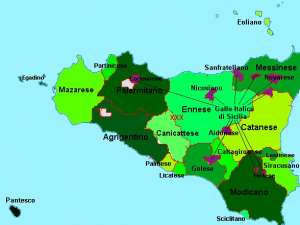
Gallic-Italic dialect
The peculiar dialect from Nicosia, known as "Gallo-Italic" derivation from the "Franco-Lombard spoken" of Monferrato, is to be traced back to the Lombard colonization of our country during the Norman rule: the Lombard colonies were in Sicily, and in Nicosia, to Adelaide following the Monferrato with Count Ruggero.
The from Nicosia Mariano La Via, from 1885 to 1887 brought out the first documents of the vernacular from Nicosia: proverbs, stories, games and popular uses, which was followed, in 1891, "jokes popular Nicosiani and sperlinghesi", containing alquanti mottos vernacular satirical and burlesque, which they were in part reproduced, along with other new, in the publication "Rivalry and fighting between Mariani and Nicoletti in Nicosia in Sicily".
The literary tradition was revived by the local pharmacist Carmelo Giglia that, with his characters (from the old to the sprightly young dandies, the slacker womanizer all`instancabile worker, the scientist in presumptuous all`ingegnere error), represented a cross section of Nicosia late nineteenth and early twentieth century.
In 1920, Angelo Barbato published "The Lombards of Sicily in the twelfth century", taking stock of the knowledge regarding the history of Lombardy Nicosia.
More recently, Professor. Nicholas Messina brings to light, by publishing them, the writings of that Giglia, otherwise destined to oblivion, and occupies much of his life trying to build a vocabulary of Italian Gallic dialect that, as far as I know, has already been completed but not published.
The study and the depth of the argument, to this day, the main speakers were Prof. Sigismundo Castrogiovanni (author of several collections relating tales and fables in the dialect of his beloved Nicosia) and prof. Found, currently the highest authority on the subject, being among others in charge of the project Gallic-Italic University of Catania.



